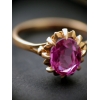|
 Precious
stones is the essential component of luxury jewelry. The demand for particular
precious stones changes every year due to fashion trends and market offers, for
sure. However, the specialists report that the material offered at the market
is for 30-70 % counterfeited product. This means only that such stones should
be estimated and rated by professionals to ensure you purchase the high quality
product. Precious
stones is the essential component of luxury jewelry. The demand for particular
precious stones changes every year due to fashion trends and market offers, for
sure. However, the specialists report that the material offered at the market
is for 30-70 % counterfeited product. This means only that such stones should
be estimated and rated by professionals to ensure you purchase the high quality
product.
Precious stone and rating
Precious stones
are not rated by single value. From the view of beauty, rarity and durability
rating, almost all natural stones refer to precious stones, along with
synthetic ones. The specialists hemotologists somewhat restrict that notion to
minerals of crystalloid structure colorless or with the vivid single-colored
shade, luster, transparency, and high rigidity. Natural diamond, emerald, ruby,
sapphire, alexandrite, pearl as natural stones as well as amber structure refer
to precious stones.
Prior to be
rated precious the stone has to be tested in several phases. First, the specialists
either prove or eject the authenticity of natural origin to exclude the
synthetic interference with the purpose to refine or the artificial formation
of the nugget. Second, more through investigation is held to take the utmost
conclusion of the stone value. The essential criteria in here is the size, carats
or weight, shape, homogeneity of the material and color, various possible
defects and other individual features.
Non-organic precious stone rating
Non-organic
precious stones include the diamond, emerald, ruby, sapphire and alexandrite.
The rule of four C is used commonly in most countries as of color, carat,
clarity and cut. This system is used in USA to rate diamonds, semi-precious
stones and pearls.
Color
rating is done by the existing gradation system. So, there are 23 tints for the
white diamond from translucent as D to white-yellow as Z. some finer
characteristics are measured for fancy diamonds considering richness, homogeneity,
coloration extent. The other precious stones are rated by the color scale providing
324 variations. Sometimes the deep richness, evenness and juiciness of color influence
upon the final cost of the stone to the greater extent than any other
parameters. So, traditionally 50% of the cost for the precious stone is the
color.
As for the
quality, diamonds are divided into 11 groups from ideally pure without any
defects and inclusions to those with visual defects. Seven quality categories
are accepted for other stones though the purity assessment is done individually
for every single semi-precious stone, as emerald or ruby, for example.
Diamond cutting
is classified in four quality grades from 4 as low to 1 as upper. For other
stones the assessment is not that strict.
The professionals
also pay attention to the quality of stones by rigidity, rarity and beauty. So,
diamond’s rigidity on Mohs scale is 10, though it is frequently mined natural
precious stone. And it is rare to mine the large diamond especially when after
processing it becomes the most shining among all other precious stones.
Rating of
pearls and amber
The assessment
of such precious stones as pearl and amber is done by the same system as for
semi-precious stones excluding the quality of cutting. The system is the most
common and contains such rating parameters as tint, shape, size, depth applicable
for the layer of pearl, luster and color. Place of origin adds to the final cost
of the pearl when the sea and natural pearl is far more expensive than that
from river and cultivated. Amber with some inclusions like fossil insects,
lizards or frogs is found to be the exclusive discovery to appear in private
collections.
It is not
possible to assess the value of precious stones at home without expertise professionals
and required tools. The assessment is done visually when the precious stone is
placed onto the ideally white-snow sheet of paper. In the day light all
defects, inclusions and cracks are seen by eye and with magnifying glass. The evenness
and cutting correctness and accurateness are also defined visually. However,
the perfect purity is impossible to determine in such a way. Assessment of
precious stones by professionals is the most beneficial procedure, especially
when the qualification, expertise and tools can contribute to rating of
precious stones perfectly and unbiased. And this is up to any precious stone owner
to choose for the way to assess the value of their stones.
|